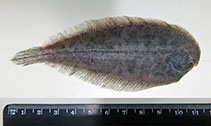| Family: |
Achiridae (American soles) |
| Max. size: |
13.1 cm TL (male/unsexed) |
| Environment: |
demersal; freshwater; brackish; marine, amphidromous |
| Distribution: |
Western Atlantic: estuarine areas of the Orinoco (Venezuela), Corantijn (Suriname), Oyapock, Amazon and Grajaú (Brazil) rivers, and from marine areas under influence of these rivers. Enters low land freshwaters - there are records from Jari River (Brazil) and Corantijn River (Suriname). |
| Diagnosis: |
Dorsal spines (total): 0-0; Dorsal soft rays (total): 57-75; Anal spines: 0-0; Anal soft rays: 40-55; Vertebrae: 34-38. Nostril diameter 1.5-2 times orbital diameter; color pattern consisting of a light brown background with irregular, scattered dark brown blotches, the largest ones 2-7 times interorbital space; caudal fin pointed (median rays proportionally longer than external ones); presence of gill openings on both eyed sides; absence of scales on the interorbital space (Ref. 49504). |
| Biology: |
Rare. Adults occur over sandy-muddy bottoms of the littoral zone and estuaries. Little is known of its biology (Ref. 35237). Maximum length reported to reach 15 cm TL (Ref. 5217). |
| IUCN Red List Status: |
Least Concern (LC); Date assessed: 24 August 2012 Ref. (130435)
|
| Threat to humans: |
harmless |
Source and more info: www.fishbase.org. For personal, classroom, and other internal use only. Not for publication.

